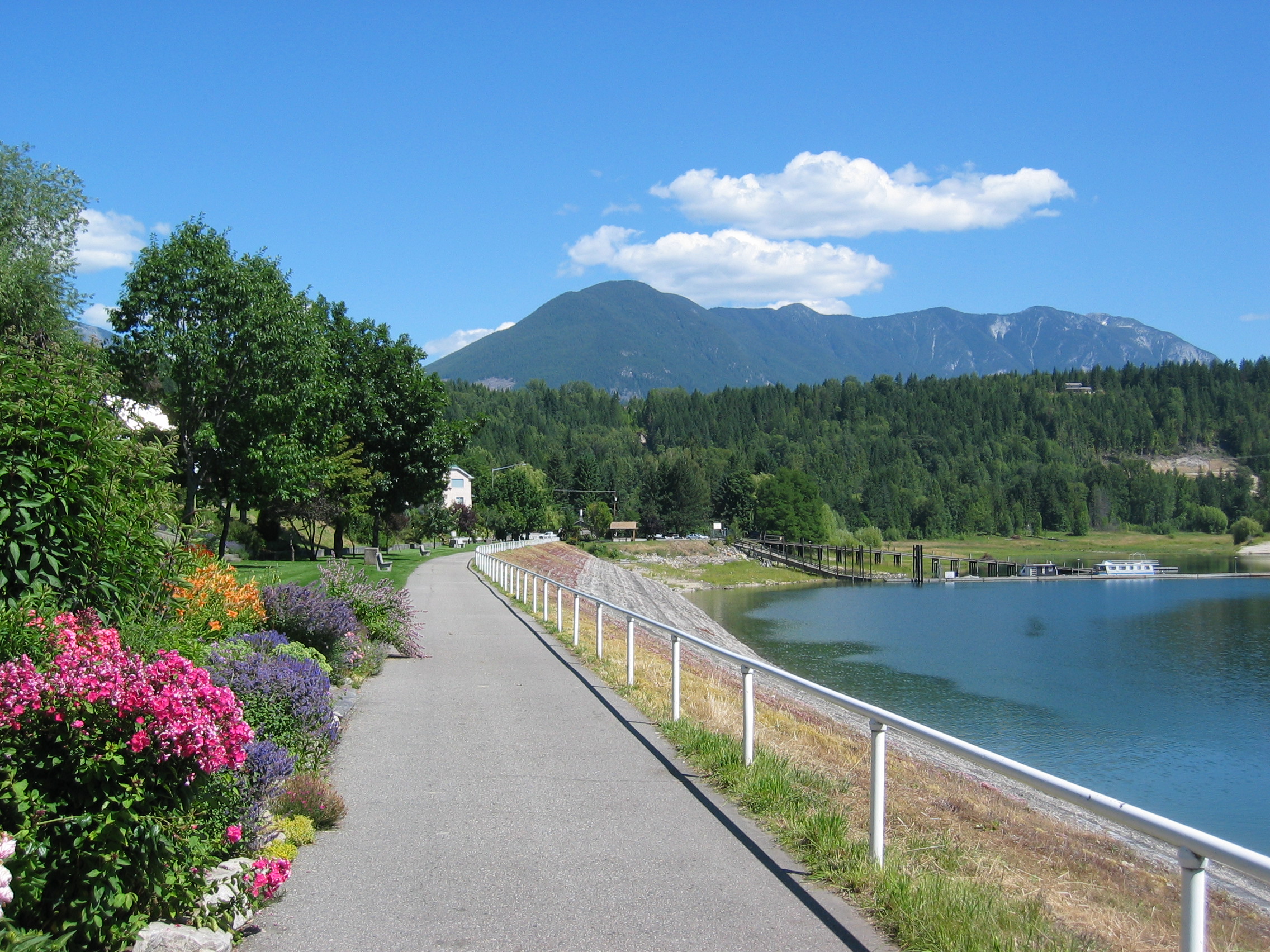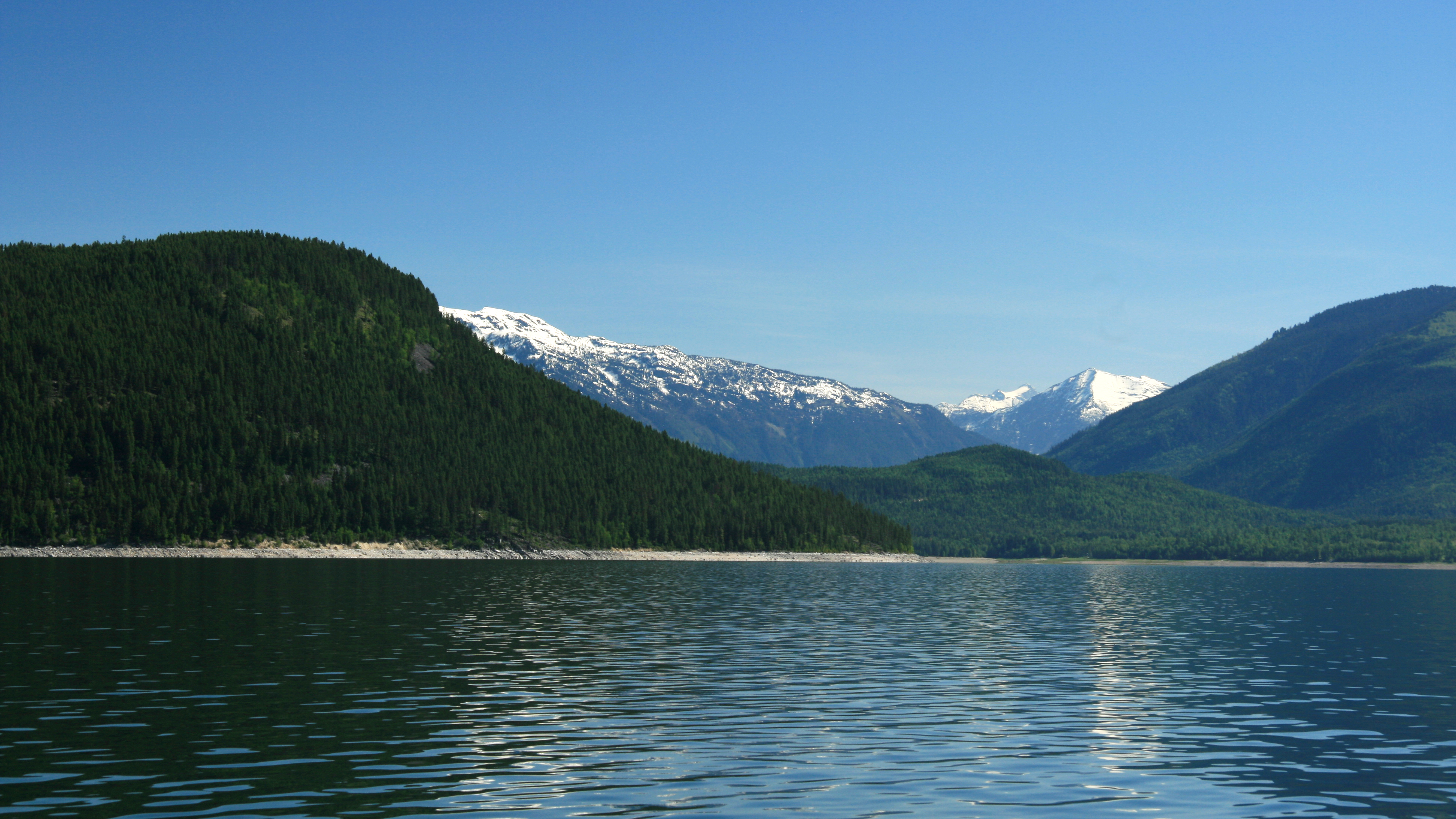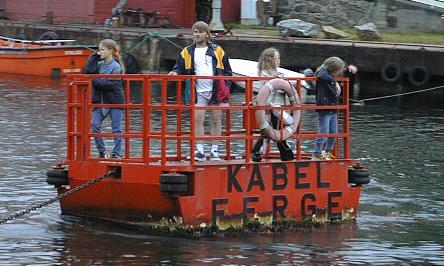|
Arrow Lakes
The Arrow Lakes in British Columbia, Canada, divided into Upper Arrow Lake and Lower Arrow Lake, are widenings of the Columbia River. The lakes are situated between the Selkirk Mountains to the east and the Monashee Mountains to the west. Beachland is fairly rare and is interspersed with rocky headlands and steep cliffs. Mountain sides are heavily forested, and rise sharply to elevations around . Originally two lakes apart, the Arrow Lakes became one lake due to the reservoir created by the 1960s construction of the Keenleyside Dam; at low water the two lakes remain distinct, connected by a fast-moving section known as the Narrows. Damming the Lower Arrow Lake resulted in water rising above natural levels. As a result of higher water, the valley lost two-thirds of its arable land. Approximately two thousand people were relocated. The lake stretches from just north of Castlegar in the south to Revelstoke in the north. Another hydroelectric development Whatshan Dam, dive ... [...More Info...] [...Related Items...] OR: [Wikipedia] [Google] [Baidu] |
Nakusp, British Columbia
The Village of Nakusp () is located south of the mouth of Kuskanax Creek, on the Upper Arrow Lake in the West Kootenay region of southeastern British Columbia. Lying between the Selkirk Mountains, Selkirk and Monashee Mountains, Monashee ranges, the village is known for its nearby hot springs and picturesque mountain lakeside setting. Early history The Secwepemc, Sinixt, and Ktunaxa peoples occupied the region for thousands of years. In 1811, Finan McDonald, a member of David Thompson (explorer), David Thompson's party, was the first reported European explorer on the Arrow Lakes. The settlement name came from the Nakusp Creek to the south. As to the word meaning, suggestions have included an eddy, safe place (sheltered bay), a coming together (of the lake, which narrowed at this point prior to the dam), a private body part, and having buffalo, despite no evidence buffalo ever roamed the area. Demographics In the 2021 Canadian census, 2021 Census of Population conducted ... [...More Info...] [...Related Items...] OR: [Wikipedia] [Google] [Baidu] |
Keenleyside Dam
Hugh Keenleyside Dam (formerly known as the High Arrow Dam) is a flood control dam spanning the Columbia River, 12 km (6.5 miles) upstream of the city of Castlegar, British Columbia, Canada. Dam The dam is at the outflow of what was the upper and lower Arrow Lakes; today the two lakes are joined forming one long reservoir extending north to Revelstoke Dam, and contains 8.76 km3 (7.1 MAF) of reservoir volume. The dam is operated by BC Hydro. The long earth fill and concrete dam was built as part of fulfilling Canada's obligations under the Columbia River Treaty, along with the Duncan Dam, both were built to prevent flooding and control the flow of water in the Columbia River for downstream hydroelectric dams. It was commissioned on October 10, 1968, six months ahead of schedule. Immediately downstream of the dam a 185 megawatt (MW) hydroelectric Hydroelectricity, or hydroelectric power, is Electricity generation, electricity generated from hydropower (water ... [...More Info...] [...Related Items...] OR: [Wikipedia] [Google] [Baidu] |
Castlegar, British Columbia
Castlegar is a community in the West Kootenay region of British Columbia, Canada. In the Selkirk Mountains, at the confluence of the Kootenay River, Kootenay and Columbia Rivers, it is a regional trade and transportation centre, with a local economy based on forestry, mining and tourism. Castlegar is home to Selkirk College, a regional airport, a pulp mill, and several sawmills. Its population of 8,338 includes many Doukhobors, who were largely responsible for much of the town's early development and growth. The area which became Castlegar was an important centre for the Sinixt (Lakes) Peoples. Outside the city limits are the small surrounding communities of Ootischenia, Brilliant, Robson, British Columbia, Robson, Robson West, Robson, British Columbia, Raspberry, Tarrys, Thrums, Glade, Shoreacres, Fairview, Genelle, Pass Creek and Krestova, and the much smaller communities of Deer Park, Renata, and Syringa on Lower Arrow Lake. These outlying areas have a further population of a ... [...More Info...] [...Related Items...] OR: [Wikipedia] [Google] [Baidu] |
Galena Bay, British Columbia
:''Not the Galena Bay on Kootenay Lake at Riondel '' Galena Bay is an unincorporated locality, on the bay of the same name, at the head of Upper Arrow Lake in the West Kootenay region of southeastern British Columbia. The Sinix't Nation, or Lake People, used the bay annually, at least, for hunting and fishing.Parent, Milton, 1993. Silent Shores and Sunken Ships Vol. 3. Arrow Lakes Historical Society. . A productive run of kokanee salmon ("redfish" in the local parlance) would have made it an attractive camp in the autumn. The Sinix't name for the bay mean "the place to make canoes" because the large cottonwoods made excellent dugouts. In 1894, the shooting of Cultus Jim, a Sinix't man, was an infamous event that followed several violent interactions between the Sinix't and white settlers, recounted by Parent. Cultus Jim was protecting his family's traditional right to camp in Galena bay and was shot by a settler, Samuel Hill, who had homesteaded a farm in Galena Bay in 1893. Hi ... [...More Info...] [...Related Items...] OR: [Wikipedia] [Google] [Baidu] |
British Columbia
British Columbia is the westernmost Provinces and territories of Canada, province of Canada. Situated in the Pacific Northwest between the Pacific Ocean and the Rocky Mountains, the province has a diverse geography, with rugged landscapes that include rocky coastlines, sandy beaches, forests, lakes, mountains, inland deserts and grassy plains. British Columbia borders the province of Alberta to the east; the territories of Yukon and Northwest Territories to the north; the U.S. states of Washington (state), Washington, Idaho and Montana to the south, and Alaska to the northwest. With an estimated population of over 5.7million as of 2025, it is Canada's Population of Canada by province and territory, third-most populous province. The capital of British Columbia is Victoria, British Columbia, Victoria, while the province's largest city is Vancouver. Vancouver and its suburbs together make up List of census metropolitan areas and agglomerations in Canada, the third-largest metropolit ... [...More Info...] [...Related Items...] OR: [Wikipedia] [Google] [Baidu] |
Arrow Park Ferry
An arrow is a fin-stabilized projectile launched by a bow. A typical arrow usually consists of a long, stiff, straight shaft with a weighty (and usually sharp and pointed) arrowhead attached to the front end, multiple fin-like stabilizers called fletchings mounted near the rear, and a slot at the rear end called a nock for engaging the bowstring. A container or bag carrying additional arrows for convenient reloading is called a quiver. The use of bows and arrows by humans predates recorded history and is common to most cultures. A craftsman who makes arrows is a fletcher, and one who makes arrowheads is an arrowsmith.Paterson ''Encyclopaedia of Archery'' p. 56 History The oldest evidence of likely arrowheads, dating to years ago, were found in Sibudu Cave, current South Africa.Backwell L, d'Errico F, Wadley L.(2008). Middle Stone Age bone tools from the Howiesons Poort layers, Sibudu Cave, South Africa. Journal of Archaeological Science, 35:1566–1580. Backwell L, Bradf ... [...More Info...] [...Related Items...] OR: [Wikipedia] [Google] [Baidu] |
Needles Cable Ferry
The Needles Ferry is a cable ferry across Lower Arrow Lake in the West Kootenay region of southeastern British Columbia. Linking Needles and Fauquier, the ferry, part of BC Highway 6, is by road about southeast of Vernon and southwest of Nakusp. Timeline 1913: Farmers built the first vehicle ferry using Ford Model T parts. Apart from a reference to a rudimentary raft in 1922, no evidence exists of a service most years. 1924: Government ferry launched, which comprised a log raft pushed by a launch. This free service, had a one-car capacity. 1928: Larger boat introduced. 1931: Wooden hulled cable ferry installed, having three-car capacity. Crossings were hourly. 1941: Upgraded to eight-car capacity. 1952: Upgraded to 16-car capacity. 1955: Service increased from 12 to 24 hours per day. 1967: Replacement bridge confirmed, but never eventuated. 1968: Both terminals rebuilt on submerging by the reservoir for the Keenleyside Dam. 1969: Diesel-powered ''Needles'' with 28-car cap ... [...More Info...] [...Related Items...] OR: [Wikipedia] [Google] [Baidu] |
British Columbia Provincial Highway 6
Highway 6 is a two-lane highway passing between the Kootenay and Okanagan regions in the province of British Columbia, Canada. It is divided into two parts—the Nelson-Nelway Highway between the Canada–United States border and Nelson, and the Vernon-Slocan Highway between South Slocan and Vernon. Highway 6 is a north–south highway between Nelway and the Needles Ferry and an east–west highway between the Needles Ferry and Vernon; it has a total length of . It first opened in 1941 and, aside from minor realignments along its concurrences with 3 and 3A, its very winding path through the western Kootenays has not changed since. Route description Nelson-Nelway Highway Highway 6 begins at the Canada–United States border crossing at Nelway, where it connects with Washington State Route 31. The highway parallels the Salmo River for the rivers entire length from Nelson to the border and many views of the river can be seen from the highway. From the Canada–United State ... [...More Info...] [...Related Items...] OR: [Wikipedia] [Google] [Baidu] |
Vernon, British Columbia
Vernon is a city in the Okanagan region of the British Columbia Interior, Southern Interior of British Columbia, Canada. It is northeast of Vancouver. Named after Forbes George Vernon, a former Member of the Legislative Assembly, MLA of British Columbia who helped establish the Coldstream Ranch in nearby Coldstream, British Columbia, Coldstream, the City of Vernon was incorporated on 30 December 1892. The City of Vernon has a population of 44,519 (2021), while its metropolitan region, Greater Vernon, has a population of 67,086 as of the 2021 Canadian census. With this population, Vernon is the largest city in the Regional District of North Okanagan, North Okanagan Regional District. A resident of Vernon is called a "Vernonite". History The site of the city was discovered by the Okanagan people, a tribe of the Interior Salish people, who initially named the community Nintle Moos Chin, meaning "jumping over place where the creek narrows". This name refers to a section of the Swan ... [...More Info...] [...Related Items...] OR: [Wikipedia] [Google] [Baidu] |
West Arrow Park
West is one of the four cardinal directions or points of the compass. It is the opposite direction from east and is the direction in which the Sun sets on the Earth. Etymology The word "west" is a Germanic word passed into some Romance languages (''ouest'' in French, ''oest'' in Catalan, ''ovest'' in Italian, ''vest'' in Romanian, ''oeste'' in Spanish and Portuguese). As in other languages, the word formation stems from the fact that west is the direction of the setting sun in the evening: 'west' derives from the Indo-European root ''*wes'' reduced from ''*wes-pero'' 'evening, night', cognate with Ancient Greek ἕσπερος hesperos 'evening; evening star; western' and Latin vesper 'evening; west'. Examples of the same formation in other languages include Latin occidens 'west' from occidō 'to go down, to set' and Hebrew מַעֲרָב (maarav) 'west' from עֶרֶב (erev) 'evening'. West is sometimes abbreviated as W. Navigation To go west using a compass for navigati ... [...More Info...] [...Related Items...] OR: [Wikipedia] [Google] [Baidu] |
Cable Ferry
A cable ferry (including the types chain ferry, swing ferry, floating bridge, or punt) is a ferry that is guided (and in many cases propelled) across a river or large body of water by cables connected to both shores. Early cable ferries often used either rope or steel chains, with the latter resulting in the alternative name of chain ferry. Both of these were largely replaced by wire cable by the late 19th century. Types Cable ferries can be typified by their size and construction, their usage (passenger, animal, vehicle) and requirements (length of crossing, amount of other shipping), their cables (wire rope, chain, or both), and their propulsion (water current, engine, manual). The choice of cable depends partially on the requirements of the crossing but also on the historical context. For example, the numerous cable ferries across Australian and Canadian rivers seem to use wire rope exclusively, whereas the older crossings across busy tidal rivers in England all use chain. ... [...More Info...] [...Related Items...] OR: [Wikipedia] [Google] [Baidu] |
East Arrow Park
East is one of the four cardinal directions or points of the compass. It is the opposite direction from west and is the direction from which the Sun rises on the Earth. Etymology As in other languages, the word is formed from the fact that east is the direction where the Sun rises: ''east'' comes from Middle English ''est'', from Old English ''ēast'', which itself comes from the Proto-Germanic *''aus-to-'' or *''austra-'' "east, toward the sunrise", from Proto-Indo-European *aus- "to shine," or "dawn", cognate with Old High German ''*ōstar'' "to the east", Latin ''aurora'' 'dawn', and Greek ''ēōs'' 'dawn, east'. Examples of the same formation in other languages include Latin oriens 'east, sunrise' from orior 'to rise, to originate', Greek ανατολή anatolé 'east' from ἀνατέλλω 'to rise' and Hebrew מִזְרָח mizraḥ 'east' from זָרַח zaraḥ 'to rise, to shine'. ''Ēostre'', a Germanic goddess of dawn, might have been a personification of both da ... [...More Info...] [...Related Items...] OR: [Wikipedia] [Google] [Baidu] |







